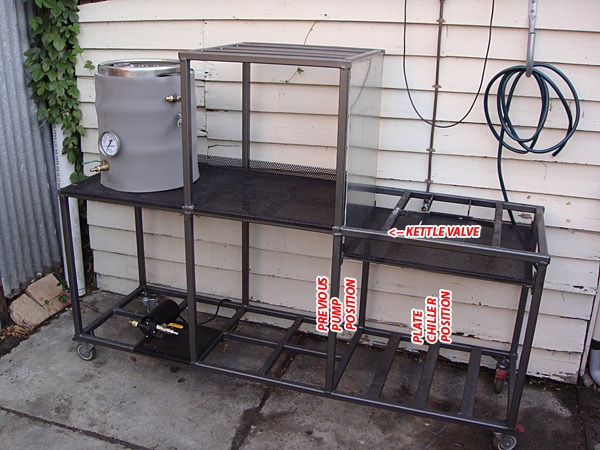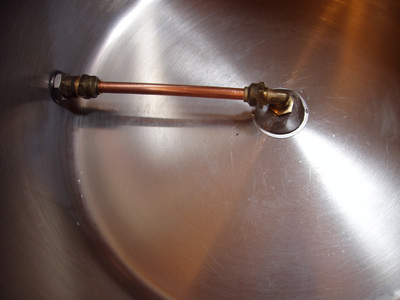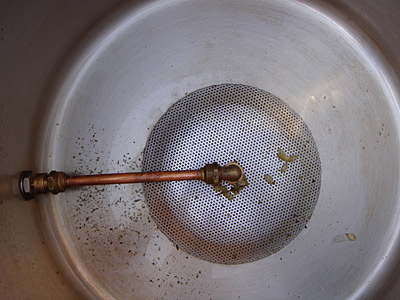reVoxAHB
Well-Known Member
- Joined
- 3/3/07
- Messages
- 1,112
- Reaction score
- 17
Hi Gang,
I recently relocated my March 809 from the right side of my brew frame to the left lower area as shown:

The pump was mounted vertically, so to speak, so that in was down output/up, whereas now (again shown) the pump is horizontal, in on left/out at right. As a quick note, I have no priming issues; fine priming in either orientation.
With the pump mounted dead beneath my kettle and plate chiller close by, my longest run of silicone hose (to complete kettle --> pump --> chiller --> ferms) was 1 meter, with various little bits here and there to complete the setup. Now, the longest run (again, silicone throughout brewery) is 3m, and 2m back again, with various bits.
Having brewed on two occasions with the pump now at left, it would appear I've lost a tremendous amount of suck. My little ghetto hop filter screen (in kettle) that no-one could figure out how I was able to use without clogging (even all-pellet brews) clogged straight away:

I accepted this, and moved on to a 9" falsie (thanks Hutch!) thinking it would be less restrictive and compensate for new length of run.

No joy . Did a second brew using 230g pellet and 70g flower and again clogged, nearly straight away. I pulled the hose from the kettle valve at stuck run off and indeed confirmed nothing more than a trickle was coming thru the falsie (ruling out plate chiller clog, etc.). I started run-off very slowing afaik, massaging both the flow rate of kettle and output of pump so I don't think I pulled too much too fast creating a dense bed. Only thing I can think is my pump flow/suck rate has decreased significantly from new placement.
. Did a second brew using 230g pellet and 70g flower and again clogged, nearly straight away. I pulled the hose from the kettle valve at stuck run off and indeed confirmed nothing more than a trickle was coming thru the falsie (ruling out plate chiller clog, etc.). I started run-off very slowing afaik, massaging both the flow rate of kettle and output of pump so I don't think I pulled too much too fast creating a dense bed. Only thing I can think is my pump flow/suck rate has decreased significantly from new placement.
So the question is, have other brewers noticed a change in flow rates/overall performance with:
Pump position in relation to the rest of gear?
Pump orientation eg vertical/horizontal?
The pump was shifted left to be more integral with my HERMS.
Any tips on best placement? Centre or shifted (with some form of temporary mount) from left at HERMS to right at chill? I have already ruled out purchasing a second 809 :lol: , fwiw.
Cheers,
reVox
I recently relocated my March 809 from the right side of my brew frame to the left lower area as shown:

The pump was mounted vertically, so to speak, so that in was down output/up, whereas now (again shown) the pump is horizontal, in on left/out at right. As a quick note, I have no priming issues; fine priming in either orientation.
With the pump mounted dead beneath my kettle and plate chiller close by, my longest run of silicone hose (to complete kettle --> pump --> chiller --> ferms) was 1 meter, with various little bits here and there to complete the setup. Now, the longest run (again, silicone throughout brewery) is 3m, and 2m back again, with various bits.
Having brewed on two occasions with the pump now at left, it would appear I've lost a tremendous amount of suck. My little ghetto hop filter screen (in kettle) that no-one could figure out how I was able to use without clogging (even all-pellet brews) clogged straight away:

I accepted this, and moved on to a 9" falsie (thanks Hutch!) thinking it would be less restrictive and compensate for new length of run.

No joy
So the question is, have other brewers noticed a change in flow rates/overall performance with:
Pump position in relation to the rest of gear?
Pump orientation eg vertical/horizontal?
The pump was shifted left to be more integral with my HERMS.
Any tips on best placement? Centre or shifted (with some form of temporary mount) from left at HERMS to right at chill? I have already ruled out purchasing a second 809 :lol: , fwiw.
Cheers,
reVox




